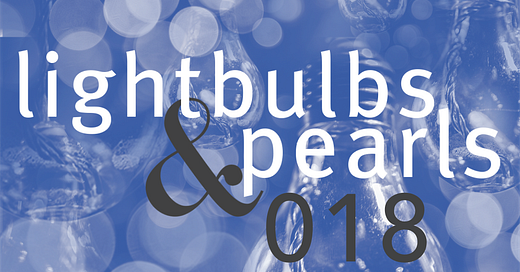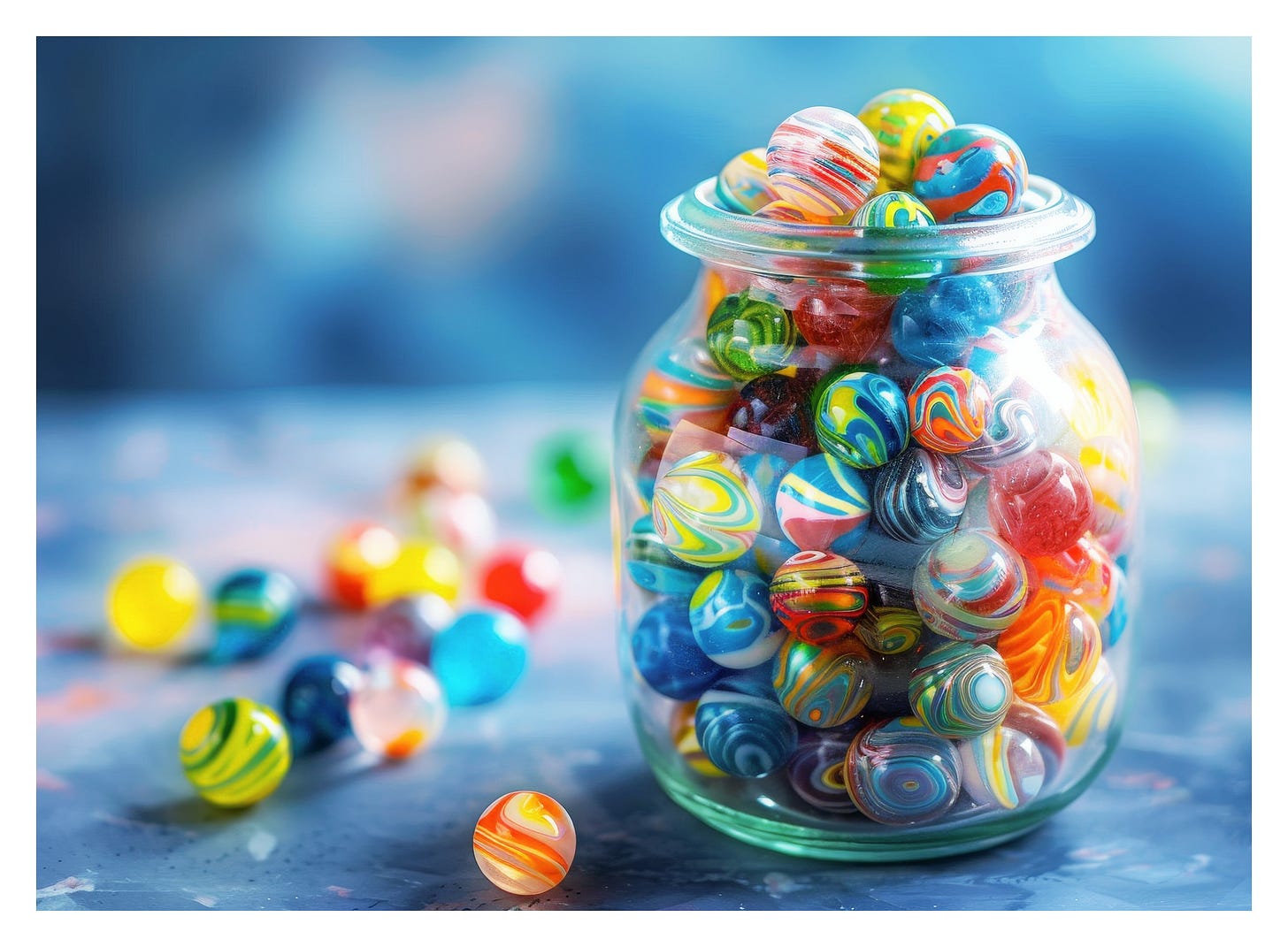Fructose Fuels Cancer, Beverage pH and Teeth, Better Flushing, My Marble Theory
Lightbulbs & Pearls | 018
Fructose Fuels Cancer Cell Growth
I don’t know about you, but recently, I have more than a handful of friends who have received a cancer diagnosis, either for themselves or for a close family member. Sadly, a good friend’s father passed away several days ago from a very short yet intense fight with cancer. She was relating how quickly it all happened so quickly that they were understandably caught off-guard and unprepared. As a result, in hindsight, she’s not sure he chose the correct strategy in dealing with the disease. It is a terrible thought for her and her mom to live with.
The rising rates of cancer are very troubling, and the root causes are a complex, knotted web, making it a daunting issue. But research is turning over many stones, uncovering new insights on fighting and perhaps even avoiding this pernicious disease. One such case is a new study published in Nature, which identifies a link between the intake of dietary fructose and the development of cancers.
Although it has been known that cancer cells use glucose for energy and growth, this study illuminates how fructose differs from glucose in how it is metabolized by the liver and harnessed by cancer cells for development. This may, in part, explain the rising rates of cancer paralleling the increased prevalence of high-fructose corn syrup in highly processed foods. The study is enlightening because it demonstrates the previously unknown backdoor mechanics of how fructose is broken down in the liver, creating an enzyme that feeds tumors.
Now imagine a diet containing both dietary glucose, found in many carbohydrates, and high-fructose corn syrup, found in processed foods; together, these produce essentially high-octane cancer fuel. While there isn’t a simple answer to cancer, eliminating a couple of the known fuel sources that feed tumors is a good place to start.
Clean up your diet now to give your body the best chance to fend off cancer or, God forbid, successfully fight it. Start by eliminating all highly processed, packaged foods. I cook and bake most of what I eat; that way, I can control both the quality of the ingredients and the ingredients themselves.
How Beverage pH Levels Affects Teeth
The health of our teeth is paramount as we age, and I found an article on Dr. Michelle Jorgensen’s Living Well site, "How Acidic Drinks Affect Your Teeth: pH Levels and What You Need to Know," very illuminating. I didn’t realize that the leading cause of cavities is demineralization, and acid is the biggest culprit.
Essentially, acid pulls minerals from the teeth, eroding tooth enamel and exposing the softer, more vulnerable dentin layer, which, over time, can lead to decay. pH is a measure of how acidic or alkaline a substance is. A pH level of 7 is neutral, and anything lower than 7 is acidic; the lower the pH, the higher the acid. The goal for healthy teeth is to consume primarily neutral-pH drinks.
Remembering videos of Coke dissolving rust, it’s no surprise that soft drinks lead the pack of unhealthy beverages with a pH of around 2.5-3, mainly due to the common additive, phosphoric acid, and carbonation. Close on Coke’s heals are Kombucha with a level of 3 and sports/energy drinks with a pH range of 3.5-4. Diet Coke isn’t much better, clocking in at 4, along with fruit juices in the 2.5-4 range, and coffee has a pH level of 5. Tea ranges from 3-10, with herbal teas being most neutral with a 6-7 pH.
If you indulge in any of these acidic drinks, Dr. Michelle recommends using a straw and drinking all at once rather than sipping throughout the day; then rinsing with water and letting nature do the rest. Saliva is our mouth’s natural cleanser, bringing its acidity back to normal. And while brushing our teeth immediately after imbibing acidic drinks may seem logical, Dr. Michelle says this is the worst time as the teeth are then at their most vulnerable. Wait at least 30 minutes before brushing, after saliva has had a chance to work its magic.
By the way, water has a neutral pH of 7. That’s my drink of choice throughout the day.
Close the Lid Before Flushing
This is a rather indelicate subject, but I’m willing to evaluate and consider everything in pursuit of health and well-being! Although probably not common knowledge, there is something called the “toilet plume effect,” which may significantly impact our health.
As might be guessed from its picturesque name, microscopic particles of you-know-what become airborne when the toilet is flushed, permeating the air and landing on every surface within approximately six-plus feet of the toilet. A lovely thought.
For many compact bathrooms, this can mean that within the plume perimeter are toothbrushes and towels—often the moist harbors that bacteria love—that become contaminated with these unmentionable bacteria. Perhaps millions of them. I’m sure I don’t have to explain why you don’t want to brush your teeth or wipe your face with these impurities.
One simple solution is to close the lid before flushing. It’s easy peasy. For good measure, store your toothbrush far away from the toilet and replace it every 3 to 4 months. Also, hang towels away from the plume area and wash or replace them often.
It may sound like a small concern, but it adds up over time and could become a sneaky cause of illness.
Speaking of Adding Up…My Marble Theory
I sometimes feel overwhelmed trying to do all the right things, to avoid all the bad stuff, and to mitigate all the rest that I don’t even know. These feelings can be exacerbated by the pressure to keep up with the ever-changing latest silver bullet, the one-perfect product or solution to all our health woes.
Enter instead my marble theory, which grew from a passage I read when our son was a toddler. Although I didn’t read much about child-rearing from so-called experts (I thought the best course was to rely on common sense), I received a book by Dr. Sears and his wife Martha that I thought had merit, and I thumbed through it at key points in Alessio’s development.
One such time was when he was starting to eat solid foods. Alessio was a very light eater and often rather picky, which made me nervous, so I did some reading and came across a pearl of wisdom that had a far-reaching impact on me. In a nutshell, Martha told us nervous-nelly new moms not to agonize over what the child ate daily but rather to focus on what they consumed over the week. In other words, everything adds up to make a complete picture.
That’s my marble theory. Everything we do, no matter how small and seemingly insignificant, is necessary because they all add up to make the complete picture. Much like marbles in a jar. Individual marbles don’t fill much space, but together, they become a whole jar.
And so it goes with our choices concerning our health and well-being: what we eat, how we move and exercise, how much sleep we get, what kind of personal care and cleaning products we use, what sort of entertainment and information we consume, the people we surround ourselves with, and our faith. Each is a critical marble in the life jar. My goal is to fill it to the brim.











Hi Barbara, that's a good question and catch! I wasn't as clear as I could have been, so I changed it to a neutral pH, as referenced earlier in paragraph 7. In hindsight, I could have elaborated that the pH scale is 0-14, with seven being optimal. Lower than seven is acidic, and higher than seven is alkaline. Thank you for asking and helping me to clarify that.
paragraph 7: did you mean the goal for healthy teeth is “HIGH” ph drinks?